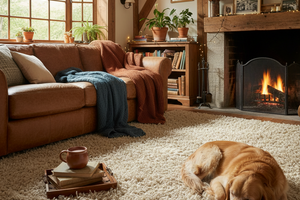Expert Advice - Engineered Wood Flooring
Share
Copy Link
Engineered wood is a beautiful and natural choice of flooring. With such a wide range of timbers, pattern and finish now available, it is becoming an increasingly popular choice throughout the home.
We catch up with Hummingbird Floors to tell us some more about engineered wood, including the cost and how to care for it.
What are the current engineered wood flooring trends right now?
We are seeing a lot of interest in Scandi style colourways, different shades of greys. Wider plank flooring is popular however there are some interesting new trends in terms of floors with varying width planks which give a really interesting look.
We are also still getting enquiries for the higher end contemporary parquets – herringbone and chevron styles. These types of floors have a modern twist from the bevelled edges providing grooves between the pieces compared to the traditional square edge, flat flooring of old.

Engineered wood floor by Hummingbird Floors
Why is engineered wood so popular and why would I choose it over solid wood?
It's popular as there are so many different ranges, colours available and it's easy to install. There are also advantages over solid wood in that it works effectively with underfloor heating, which is an increasingly common choice in contemporary homes. It also allows for effective soundproofing as there are a multitude of underlays available which can provide acoustic protection if required.
Can engineered wood be used with underfloor heating?
Engineered flooring is a more stable option than wood, so it works well with underfloor heating. The ply layers become very rigid when sandwiched together, which reduces the wood's natural tendency to expand when exposed to humidity or temperature changes.

Engineered wood floor by Hummingbird Floors
What kind of thickness of engineered wood flooring should I look out for?
You should look at a minimum 15mm thickness up to 20mm. 15mm will have lower thermal resistance and therefore better if used with an underfloor heating system.
The significant element of the board thickness is actually the wear layer – you need a minimum 3mm wear layer on the board to ensure longevity of the board.
For example, a 15mm board with a 3mm wear layer is an excellent product, will last well and will work effectively with an underfloor heating system.
A thicker board, say 20mm, would tend to have wear layers of 4-6mm. These thicker boards come into their own when using wider boards, and when we say wide, we mean more than 200mm wide, as they give increased stability.
How much does it cost for good quality engineered flooring
The big question! We would say the starting point is about £45-50 per square metre. Anything much under this level is likely to have a sub-3mm wear layer and longevity and quality is likely to be compromised.
Price variations are essentially down to the country of manufacture, whether there are any bespoke elements, and the type of oils and stains used to achieve the various colours and looks available.

Engineered wood floor by Hummingbird Floors
What should I look out for to ensure it is good quality flooring?
As noted above the wear layer thickness is always a good indicator of quality, as is the fact that the engineered board should have a hardwood plywood base not softwoods. This will ensure increased stability when using with underfloor heating too.
How do I best clean and maintain engineered wood floors and how long should it last for?
In general we would recommend always using Felt guards under furniture legs to prevent furniture damage / scratches to the floor, and would recommend regular cleaning.
Specific Cleaning instructions are tailored towards the types of finish below.
If you have a lacquered floor:
Using the correct products is a must, to ensure the shine is retained and the lacquered coating is not damaged. We recommend a combination of dry cleaning to remove dirt and dust particles, and damp cleaning to keep the floor looking brand new and protect it against scratches. Intermittently, you may have to intensively clean your floor to provide protection against continued wear.
If you have an oiled floor:
Maintaining your floor in the correct way is essential, as the oil it has been treated with has specific needs compared to other finishes. We recommend that you dry clean the floor daily with a vacuum or a soft brush to remove grit or dirt. And you should damp clean the floor at least weekly using a lightly applied specialist cleaning product. Following that you should mop the floor dry. This will both reduce the chance your floor will be scratched by abrasive particles and increase the floor’s resistance to signs of wear.

Engineered wood floor by Hummingbird Floors
Anything else I need to know?
There are a range of bespoke options available if you are interested in really personalising your floor.
Generally, you will get what you pay for. Under £30 per square metre it will likely have had corners cut during the manufacturing process, so our advice would be that if your budget only allows you to go sub £40 per square metre it's probably better to go for an excellent quality laminate.
Most of all find the right supplier and trust they know their stuff!
Published: May 18, 2021



